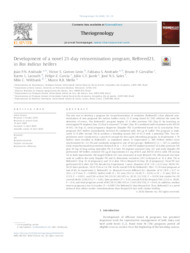Development of a novel 21-day reinsemination program, ReBreed21, in Bos indicus heifers.
Development of a novel 21-day reinsemination program, ReBreed21, in Bos indicus heifers.
Author(s): ANDRADE, J. P. N.; GOMEZ-LÉON, V. E.; ANDRADE, F. S.; CARVALHO, B. P.; LACOUTH, K. L.; GARCIA, F. Z.; JACOB, J. C. F.; SALES, J. N. S.; WILTBANK, M. C.; MELLO, M. R. B.
Summary: The aim was to develop a program for resynchronization of ovulation (ReBreed21) that allowed reinsemination of non-pregnant Bos indicus heifers every 21 d using timed AI (TAI) without the need for detection of estrus. The Rebreed21 program begins 12 d after previous TAI (Day 0) by inserting an intravaginal P4 implant (Day 12) that is removed 7 d later (Day 19) combined with treatment with 300 IU of eCG. On Day 21, early pregnancy diagnosis (Doppler PD) is performed based on CL vascularity. Nonpregnant (NP) heifers immediately received AI combined with 100 mg of GnRH. The program is replicated 12 d after second TAI to produce a breeding season (BS) of 42 d with 3 potential TAIs. Two experiments were conducted as a proof of concept for this rapid rebreeding program. In Experiment 1, 76 heifers were enrolled in ReBreed21, as explained above. In Experiment 2, 300 Nellore heifers were synchronized for 1st TAI and randomly assigned to one of two groups: ReBreed21 (n = 147) or another early resynchronization procedure, Resynch14 (n = 153) with P4 implant inserted 14 d after previous TAI plus 50 mg of long-acting injectable P4; 8 d later P4 implant removed (Day 22) and early Doppler PD performed; NP heifers received 150 mg of cloprostenol, 0.5 mg of ECP, and 300 IU of eCG with TAI on Day 24. In both experiments, the largest follicle (LF) was measured at each Resynch TAI. Ultrasound was later used to confirm the early Doppler PD and to determine ovulation (OV) to Resynch at 12 d after TAI in ReBreed21 (Day 33 of pregnancy) and 14 d after TAI in Resynch14 (Day 38 of pregnancy). Final PD was performed 40 d after 3rd TAI. Results for Experiment 1 were: diameter of LF 11.8 ± 0.23 mm; 88.9% OV; 20.5% false positives; 38.1% P/AI at 1st TAI; 44.4% overall P/AI for ReBreed21 TAIs; 72.3% total pregnant at end of BS. In experiment 2, Rebreed21 vs. Resynch14 were different for: diameter of LF (10.9 ± 0.17 vs. 10.0 ± 0.17 mm, P = 0.0003), heifers with LF < 8.5 mm (10.2 vs. 26.4%, P = 0.04), or LF 11 mm (50.0 vs. 37.2%, P = 0.001), and P/AI at first TAI (29.3% [43/147] vs. 20.3% [31/153], P = 0.074) but similar for OV (overall 86.8% [239/275], P = 0.82), false positives (P = 0.52) overall P/AI for Resynch TAIs (33.6 vs. 28.8%, P = 0.4), and total pregnant at end of BS (58.5% [86/147] vs. 55.6% [85/153], P = 0.64). In addition, median time to pregnancy was 9 d earlier (P = 0.0007) for ReBreed21 than Resynch14. Thus, ReBreed21 is a novel protocol that allows earlier reinseminations than Resynch14 but with similar fertility.
Publication year: 2020
Types of publication: Journal article
Unit: Embrapa Acre
Keywords: Animal breeding, Artificial insemination, Bos Indicus, Breeding methods, Cruce de animales, Gado Nelore, Gado Zebu, Heifers, Inseminación artificial, Inseminação Artificial, Métodos de mejoramiento genético, Nellore, Novilho, Ovulación, Ovulation, Ovulação, Razas zebú, ReBreed21, Reprodução Animal, Ressincronização, Resynchronization, Vaquilla, Zebu breeds
Observation
Some of Embrapa's publications are published as ePub files. To read them, use or download one of the following free software options to your computer or mobile device. Android: Google Play Books; IOS: iBooks; Windows and Linux: Calibre.
Access other publications
Access the Agricultural Research Database (BDPA) to consult Embrapa's full library collection and records.
Visit Embrapa Bookstore to purchase books and other publications sold by Embrapa.

